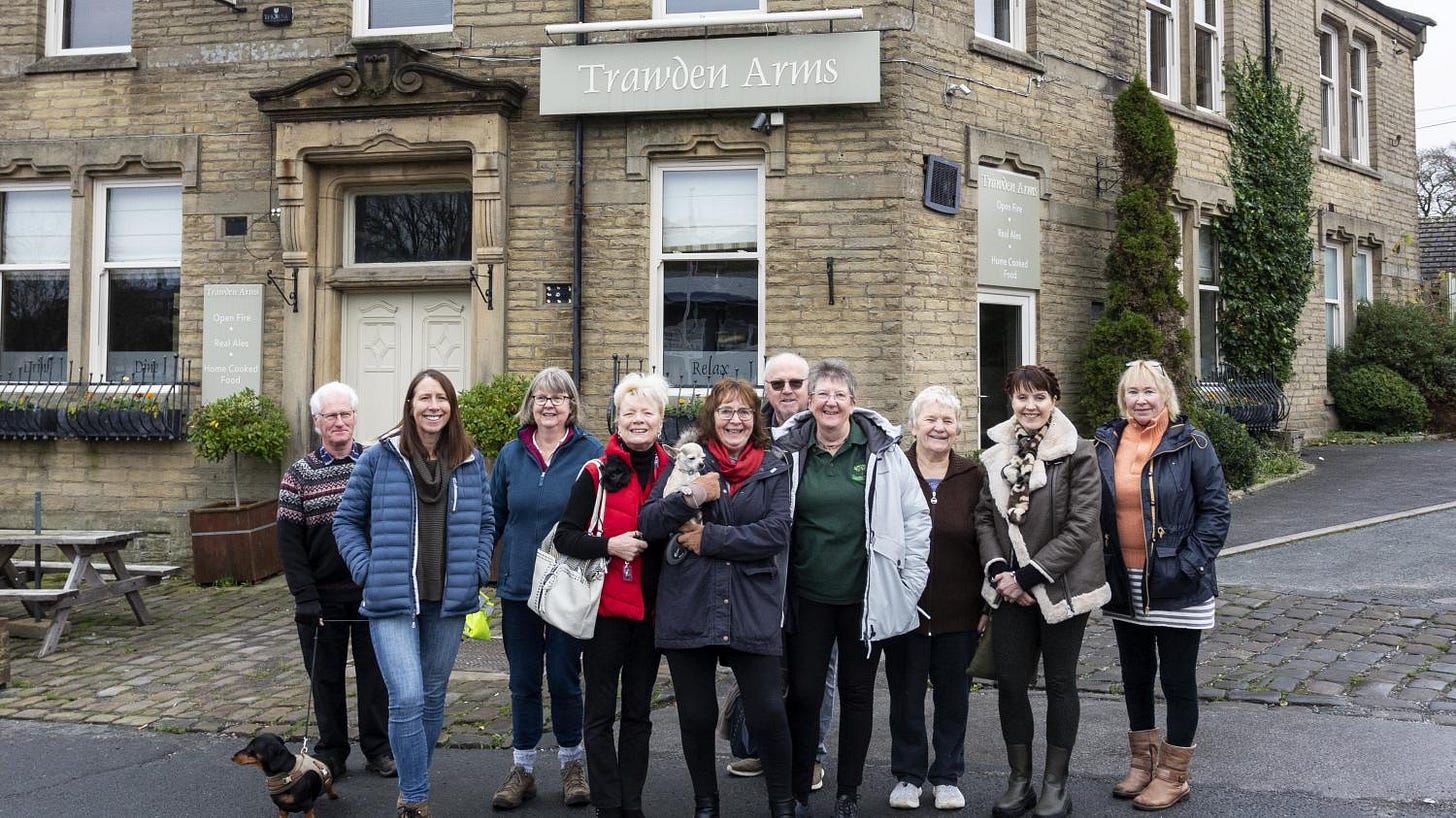The Village that Broke Free
Starting your own project is all the rage, but there are other ways to change the world.
The village pub in Trawden made over half a million in profit last year. What makes that interesting is the fact that 120 locals run the operation for free. Community-owned, the Trawden Arms is one of four establishments that has made the 2,000-person village an iconic example of what community-based organisations can achieve.
At the heart of the industrial revolution in the 19th century, East Lancashire’s future looked bleak in 2014. One by one, the fabric mills closed down in the 1970s. Other shops followed suit in the ‘80s: a butcher’s, a baker’s, a grocer’s, a post office. Four of the village’s five churches shut their doors in the following decades. Come 2014, the library was open just four hours a week, and used buckets to catch raindrops from the roof. The community centre was slated to close down.
It would have done, had local villagers not bought the building for £1 that year. In the almost-decade since, they set up a cooperative to run the centre, the library, and a shop. Seeing what the community can do, two of every three local households contributed over £500 each to buy the Trawden Arms pub in 2021.
Trawden villagers also took a grant from the Plunkett Foundation, a charity which supports community-run schemes across the UK, where locals own shares in a business and have equal voting rights (regardless of contribution). This anecdote is not just a one off: Plunkett has backed 600 businesses to trading stage since 2013; of the 150 pubs they have supported, all but one are still going today (according to this post-covid Telegraph article).

It goes to show how a small community driven towards a shared purpose can change the world. I see a ‘community’ simply as a group of people who are in some way invested in one another (eg: people born in the same area or who own the same things), and when it’s clear who is a member of the community and who isn’t. The more visible and significant that marker is, the stronger the ties between members.
Default community
But strength isn’t everything. As Oscar Wilde wrote, “To live is the rarest thing in the world. Most people exist, that is all.”
Most communities just exist. Indeed, the communities with the strongest ties often ‘exist by default’. Nobody made them, nobody actively brought people together. This is what makes their community ties so strong. Through ‘existing by default’, it feels like they have always been there. It is difficult to imagine life without the community.
However, the permanence of these kinds of ties belies their dynamism. These communities are not actively created by someone on purpose. That’s the point. They appear to exist by default. But as a consequence, they lack the dynamism that a more intentional community would have. Members are motivated more by their ties to each other than a specific goal.
Designed community
We might put those Default Communities on one end of the spectrum, defined by their apparent ‘default’ existence and characterised by stronger ties but weaker dynamism. On the other end lie Designed Communities, where the investment that makes you a member of the community is more contrived, like buying an item or signing up online.
For me at least, this phrase prompts exactly the right emotions for this side of the spectrum. ‘Designed community’ almost seems like a contradiction in terms. We intuitively expect weaker ties, I think. But in being designed with a purpose in mind, Designed Communities can be impactful: not only has the community come into existed to serve a clear purpose, but every member has joined to work towards that purpose too.
Movember and Wikipedia are excellent examples. Very few people imagined themselves writing an encyclopaedia entry before Wikipedia, and even fewer seriously bonded with others over shared upper facial hair. But today there are 45 million Wikipedians, whilst 6 million people have raised money for Movember, mobilising almost a billion dollars to stop men dying too young. These are communities designed for specific purposes, and are built on no pre-existing ties between members. Members are inspired by the purpose; the community ties come after you join, not before.
Coincidental community
The middle ground is the Coincidental Community, where members have formed ties without any active intention, around a shared interest that predates the community label, like for a shared love of a musician. Because these coincidental communities tend to form around specific ideas, they are able to act upon the world when motivated by leaders linked to those ideas.
Coincidental communities are why journalists have found themselves exploring questions like “How K-pop fans became a political force to be reckoned with”. That headline came in 2020, when fans of K-pop bands like BTS, the world’s top selling music act, registered tickets at a Donald Trump rally en masse, only to not show up and leave empty seats.
When it was founded in 1871, the National Rifle Association was an example of a Coincidental Community. Americans already owned guns, and formed a community around that shared interest. Today, as the NRA has evolved into a pressure group, it has shifted towards the Designed Community side of the spectrum.
Coincidental Communities exhibit ties that are as strong as a member’s investment in the original idea, whether that’s a love of K-pop or gun ownership. Their dynamism comes from when a clear leader advocates for something, like how Taylor Swift leads her Swifties fans, or when many grassroots members do the same. For example, BTS fans bought out ad space across Seoul subway to celebrate an anniversary for the band in 2018. The empty seats at the Trump rally is another example of the grassroots leadership kind.

The Community Spectrum
Notable communities, like those mentioned above, embrace their strengths and overcome their weaknesses. Trawden made great use of its strong local ties, but only succeed because the community was injected with dynamism. Movember and Wikipedia have both had great success, but only because they created strong bonds within their communities.
K-pop fan groups are coincidental communities. Unlike Movember and Wikipedia, the characteristic which unites coincidental communities, a love of Korean music, existed before the ‘K-pop fan’ label came to define them. But not so long before that a world without K-pop is unimaginable to their members, like it is in default communities.
There is an advantage in this though. In being actively created, there is much more potential for dynamism than in default communities. Though not so much dynamism as in a specifically-designed community, like Movember. This is, of course, the middle ground.
Organisations like the NAACP and the Black Lives Matter movement fall in between default and coincidence, because in being ‘actively created’, they have more dynamism than a passive community like small villages, but are based on a very established characteristic (being black, largely pre-ordained for each person), which underpins strong ties.
I place most political parties in between coincidence and design. That’s because political parties are designed specifically to advance certain goals, but unlike Movember and Wikipedia, political parties have members who, by coincidence, share the relevant political interests in common (these interests are not pre-ordained).1
Where communities fall on the spectrum is up for debate, but I think the existence of the spectrum is useful in itself. Today, there is enormous interest in building new communities, but it is not the case that if you want to change the world, you have to start anew.
Creating your own community has its advantages, but communities with strong ties that already exist have their own distinct qualities too. Framing them in the context of a spectrum, rather than a hierarchy, helps make that point clear. Stories like Trawden illustrate just how impactful these communities can be.
Some political parties, including single-interest groups like anti-EU parties, are much more on the ‘actively designed’ side of the spectrum, because the perspective of being opposed to the EU typically does not predate membership of that community by very long. In this sense, that anti-EU perspective is not so much of a coincidence. For example, there was very little interested in ‘Brexit’ before Nigel Farage created UKIP.






